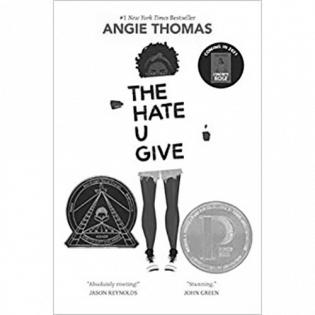The Hate You Give Literature Guide
Keywords:
Advocacy
African American
Black History
Civil Rights
Equity
Fairness
Social Justice
by Angie Thomas - A guide for parents, teachers, and group leaders to accompany the reading of this novel. The guide below provides before, during, and after-reading discussion questions. Choose from activities and discussion questions to build children's understanding of themselves and others, as well as exploring the idea of social justice and what it means in the current world we are living in.
Have you ever had to find your voice? In this story, Starr witnesses police brutality that is racially motivated and struggles to find the right way to speak up. Starr is part of two very different communities: she lives in one community and attends school in a very different community. Starr struggles to speak up because she is afraid of the reactions of others. Many U.S. communities are facing very similar situations to this story, and kids around the world are choosing to stand up and advocate for the causes they believe in. This book challenges us to consider what is our responsibility to our community and what we can each do to help.
Literature Guide by Kaitlyn Pressnall
Discussion Questions
- After reading the summary on the back of the book or the inside cover, tell about an event from the last year or two that relates to the theme of the book.
- Does the topic of this book remind you of anything in your personal life?
- In what ways does this book fit into our society today?
- Consider the Black Lives Matter Movement. How is Starr’s story similar to the origin of Black Lives Matter?
- How do we make changes in our society?
- Is it our responsibility to make things better in the world when we see something isn’t right? Why do you think that?
- What does Khalil say that “Thug Life” meant?
- What are the two versions of Starr? Why does she need to have two versions of herself? Do you have two versions of yourself? Why? Have you ever had to pretend to be someone that you aren’t to please people? What is that like? Or what do you think that would feel like?
- How does Starr define family? How do you define family?
- Why do you think Starr calls the police office by his badge number (115)?
- The violence Starr witnessed affects her relationships. Why does Starr doubt her and Chris’ relationship? Why do Hailey and Starr have conflict?
- Why does Garden Heights react in the way they do after the verdict of the police office is released?
- How has your community reacted to events that they deemed unjust?
- Starr’s mom says, “Sometimes you can do everything right and things will still go wrong. The key is to never stop doing right.” What does she mean by this, and can you relate this to a situation in your life? Or in the current media?
- In what ways has your thinking regarding racial conflict or social justice changed as a result of reading this book?
- What did you learn about yourself or others while reading this book?
- Starr Vows to “never be quiet.” If you were Starr, what vow would you take?
Activities
- Watch the TED Talk video about code switching. Code switching is alternating between two dialects of a language. It can also mean switching between the way someone expresses themselves. This is what Starr is doing as she floats between her two worlds.
- Write a personal journal entry on a time that you have code switched, including on how it has impacted you.
- Watch the movie The Hate U Give. What is different about the book and movie? Which one do you prefer?
- Define social justice and philanthropy. In what way is social justice a form of philanthropy?
- Do a presentation or research paper answering the following questions:
- Is racism taught or are people born racist?
- What are the differences in the way racism is experienced in different regions of the USA?
- Read Tupac’s poem, “The Rose that Grew Concrete.” How does this poem relate to the novel?
- Research advocacy groups that pertain to your personal interests. Call or email to see if there is anything that you can do to better your cause.
- Create a public service announcement to help your community understand code-switching.
- Learn more about the Black Lives Matter movement; what it is and how it gained traction.
- Use this toolkit from Learning to Give this toolkit to investigate the issue of equity and justice and prepare to take action.
- Follow up by reading All American Boys by Jason Reynolds.
